At the Edge of Discovery
Solving the most important challenges of our time requires an approach that cuts across the disciplines, departments, and schools. Meet four Tuck faculty members who are doing just that—by exploring and expanding the boundaries of their fields of expertise with colleagues from across Dartmouth.
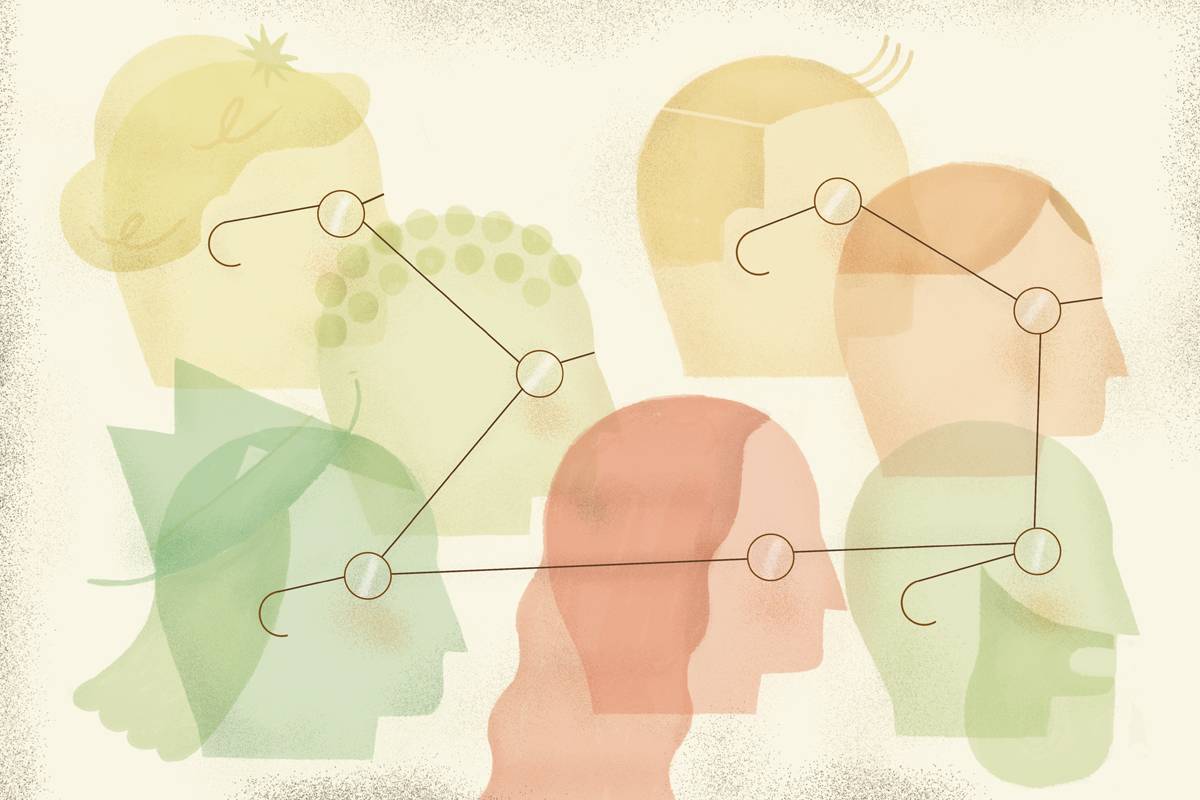
Solving the most important challenges of our time requires an approach that cuts across the disciplines, departments, and schools. Meet four Tuck faculty members who are doing just that—by exploring and expanding the boundaries of their fields of expertise with colleagues from across Dartmouth.
“The School of Athens,” one of Italian master painter Raphael’s most highly acclaimed works, depicts nearly two dozen of ancient Greece’s greatest philosophers, mathematicians, and men of science clustered in small groups, deeply engaged in conversation or other activity. Collectively these figures are meant to represent the breadth of human knowledge and the classical, collaborative spirit of the Renaissance.
The idea that scholars of various disciplines can bring individual perspectives and strengths to tackle a topic and yield unparalleled discovery is the inspiration for Dartmouth’s Cluster Initiative, a pillar of President Phil Hanlon’s academic vision for the college. It’s also a reason why Tuck faculty members regularly partner with fellow Dartmouth researchers to explore and expand the limits of their fields of expertise.
Fueling Collaboration
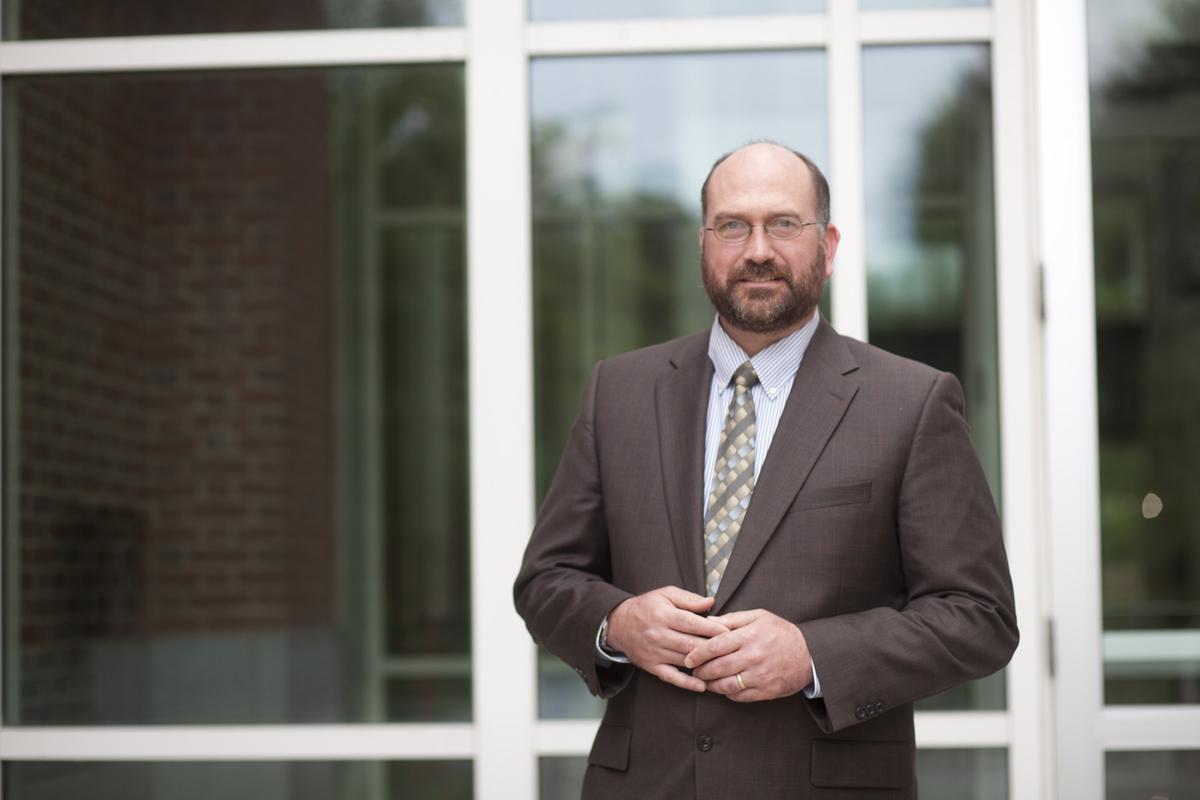
For Erin Mansur, Revers Professor of Business Administration, and his Dartmouth economics department colleagues James Feyrer and Bruce Sacerdote, collaboration begins informally. “Usually, we’ll talk about something we’ve read and chuckle, ‘Hey, we should write a paper about that,’” says Feyrer. “You know it’s a good idea when we start to get half-serious and say, ‘Well, if we were going to write a paper about that, what data would we need?’”
That’s precisely how work began on their 2014 working paper, “Where’s My Fracking Job? Geographic Dispersions of Economic Shocks from Hydrofracturing.” The idea took shape as the three read and discussed a steady stream of news stories on the practice, which involves extracting natural gas via specialized drilling techniques. What sealed their interest in writing the paper, however, was the fact that it made use of each of their particular academic specialties.
Mansur’s environmental and energy expertise meshed with Sacerdote’s interest in labor markets and Feyrer’s fascination with the macroeconomic issue of income. The researchers were also able to leverage data obtained by Feyrer and Sacerdote for a related project about the Obama stimulus package that broke down county-level employment by industry.
The resulting paper—one of the first comprehensive examinations of the effects of fracking on employment, wages, and crime—covers nearly every U.S. county from 2004 to 2012. It found that overall, fracking had an economically positive effect. For every new mining job, the authors discovered, two additional jobs are created: one in transportation and one in an indirectly-related industry.
In addition, for every million dollars of oil and gas extracted from a well, the county in which it’s located generates approximately $77,000 in wage income and $64,000 in royalty payments. Widening this circle to within 100 miles of each well reveals around $263,000 in wages and $170,000 in royalty payments for every million dollars of extracted resources.
“This project was the perfect combination of our different but overlapping skill sets, and it was exciting to examine such a topical issue,” says Sacerdote. “This entire collaboration has been fun. I can’t imagine a better place to have made it happen.”
Dartmouth, the three agree, is uniquely suited to such collaborations thanks to a receptive faculty who live and work in close proximity. This makes it all the easier to draw fresh parallels with, and inspiration from, each other’s work. “Friendships and interests cut across all fields here so that we have a general openness, open-door, open attitude that is ideal to spark collaborations across campus,” says Mansur.
How Ideas Spread
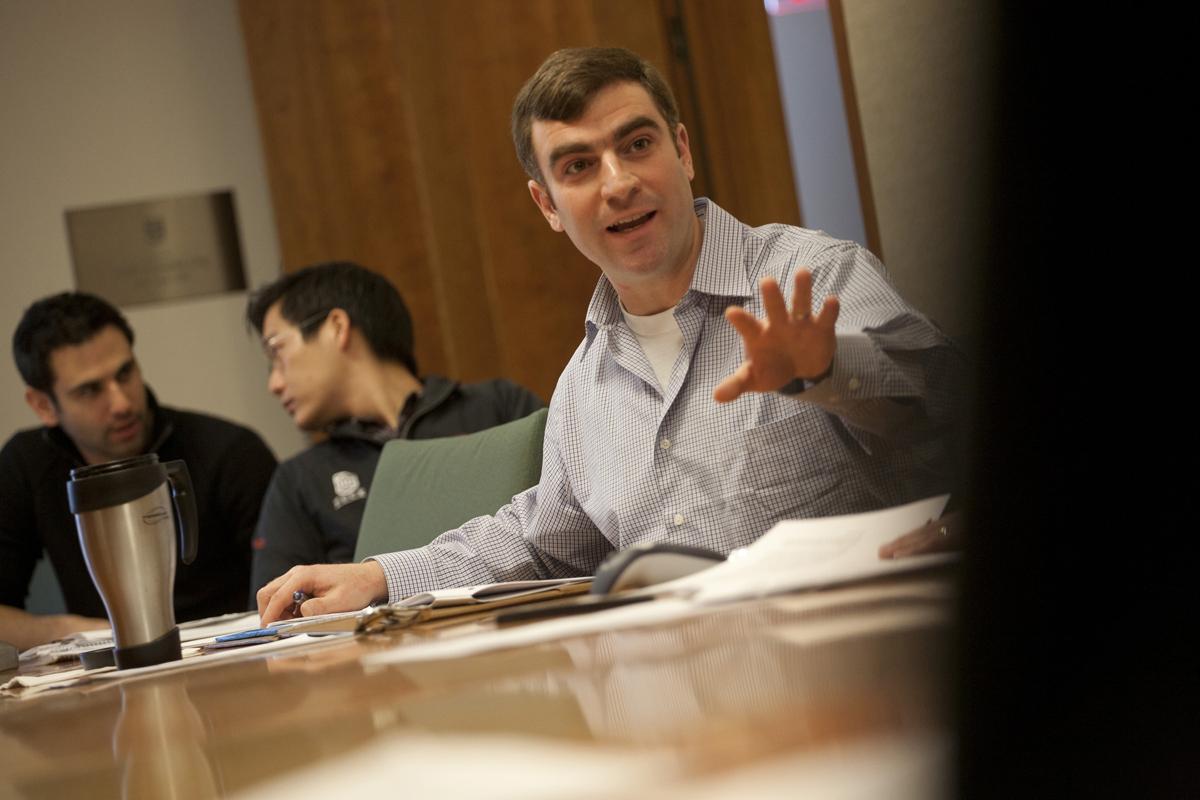
Collaboration for Tuck associate professor of business administration Adam Kleinbaum and Dartmouth’s Thalia Wheatley, an associate professor of psychological and brain sciences, began in their respective children’s first-grade classroom. Perched on tiny plastic chairs during an open house, the two associate professors struck up a conversation about Kleinbaum’s research on how social networks form, evolve over time, and impact careers and organizations.
For Wheatley, who studies social intelligence, the opportunity to join forces with Kleinbaum to approach the field of neuroscience through the lenses of interaction and social behavior was irresistible and long overdue.
The Provost’s Office at Dartmouth agreed. The researchers’ joint project, “The Spread of Ideas from Brain to Network,” was one of 10 projects it approved to share in $450,000 of seed funding set aside for the 2014-15 year.
“We know that at the macro level, information flows through networks,” Wheatley says. “That’s the social network analysis side. At the micro level—which is the neuroscientific side—there is some preliminary evidence that one person’s brain activity will align with another person’s when those people talk or share experiences. So we wanted to connect the dots: How does the network affect how those brains align?”
To determine this, the duo worked in conjunction with Kleinbaum’s core MBA course, Leading Individuals and Teams, collecting and analyzing data from students on their specific social networks. They then invite select students to participate in an fMRI study that allows them to link their network data to neuroimaging data of the participants’ actual brain processes.
Under the aegis of this project, Wheatley and Kleinbaum are conducting multiple studies, but there are two sets they deem especially interesting. In the first, they found that the brain spontaneously encodes information about the networks around us in ways that haven’t been studied before. In the second, they are examining the extent to which people who are friends have more similar brain activity patterns than people who aren’t.
While the researchers acknowledge an innate “friend selection” mechanism may be at work, they are even more intrigued by a second possibility: that the more time people spend together, the more their brains actually converge in terms of how they respond to stimuli on a neurological level.
“There’s a lot of recent evidence of this kind of neuroplasticity over the last decade, so we can’t wait to explore this further,” Kleinbaum says. “What’s most exciting for both Thalia and myself is discovering how intrinsically our two fields—which have emerged largely independently—are really linked. To study them together like this is a remarkable opportunity.”
Trading Places
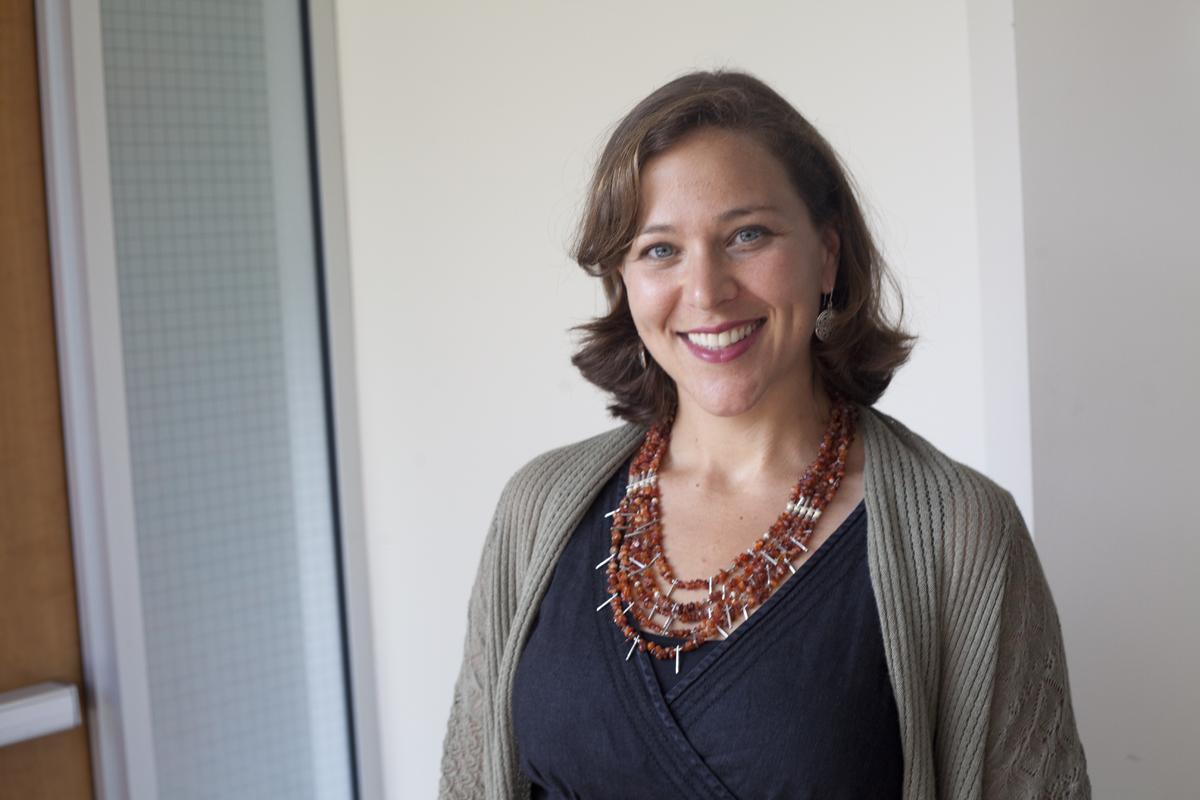
When the U.S. imports products from other countries, those imports are rarely completely foreign. In a world of complex global supply chains, much of what we import is on the return leg of a global round trip journey. “When the U.S. imports, say, a car from Mexico, that vehicle embodies a slew of upstream components that were produced in the U.S.,” explain Dartmouth professors Emily Blanchard and Robert Johnson. “The U.S. makes auto parts that are exported to Mexico, then assembled and sent back to us in the form of a car.”
Johnson, an assistant professor in the economics department, has spent years developing methods of measuring the “value-added” content embodied in final goods production, in an effort to understand the complicated webs of modern trade. Blanchard, associate professor at Tuck, has in turn spent years studying the impact of foreign direct investment (FDI) and ownership—which often correspond to global supply chains—in shaping the way countries approach international trade policy. “But I had been focused on the question of how FDI influences tariff policies through a narrow lens,” says Blanchard, whose recent empirical work demonstrates that the U.S. offers preferentially lower tariffs to countries and industries where U.S. multinational firms have offshoring-type investments, especially in the developing world. “The implications of broader global supply chain trade are potentially much, much larger quantitatively.”
If trade is about leveraging differences for mutual benefit, then Blanchard and Johnson are natural trading partners. The World Trade Organization asked Blanchard to reflect more broadly on how global supply chains and foreign investment affect trade policy on a larger scale. “But measuring global supply chains beyond just FDI is difficult in general, even more so if you want to come up with comparable numbers for a bunch of countries.” Consulting for the World Bank, Johnson was asked the same question Blanchard was thinking about—how the increasing decentralization of manufacturing and supply chains was changing the nature of international trade. “Little did I know, she had developed a theoretical framework that we could reinterpret and extend to give us an organizing structure for analyzing these questions with data,” says Johnson.
The two struck up conversation one day before the International Economics Seminar Series, run jointly by Tuck and Dartmouth’s economics department, and decided to pool their respective fields of knowledge on the issue. “I brought my specialization to the table and she brought her specialization to the table and together we’ve crafted a high-value good,” says Johnson. Pairing Blanchard’s theoretical tools and institutional knowledge of trade policy and Johnson’s value-added measurements and careful empirical methods, the two, now in concert with policy expert Chad Bown of the World Bank, have developed measures that determine the extent to which countries’ supply chains are intertwined, and how those global supply chain relationships influence each country’s trade policy.
They find that the more a country’s imports from a given trading partner embody its own domestic value-added content, the lower its tariffs will be against that country—and vice versa. Their findings have immediate practical and political implications, especially for trade agreements. “Part of the reason we don’t want to impose tariffs against Mexico is that if we hurt Mexican producers, we indirectly hurt our own [upstream] producers,” says Johnson. Likewise, Blanchard points out that “TPP can be seen partly as an outgrowth of global supply chains: lower tariffs against TPP partners that source a substantial share of their inputs from U.S. producers will help American firms and workers. Provisions like the so-called “yarn forward” initiative make plain the underlying motives. Textile and apparel products will qualify for free trade under TPP only if they use upstream yarns and fabrics that come from inside the TPP. So if the Vietnamese apparel industry ramps up its imports of fabric from the U.S. as many hope, this could be a major boon to U.S. textiles.” If we ignore the role of global supply chains in trade policy, we miss “a huge part of the story.”
This past March, the researchers presented their working paper, “Global Supply Chains and Trade Policy,” at the meeting of the National Bureau of Economics Research Program on International Trade and Investment in Cambridge, Massachusetts. “This paper never would have been written without both of us working together,” says Johnson. Moreover, adds Blanchard, the success of their partnership reflects the broader collaboration between Tuck and Dartmouth in international economics. “We have an incredible group of colleagues and mentors and a first-rate seminar series,” she says. “The simple act of getting together as a group every week to talk about research makes for a dynamic intellectual environment where everyone is just hugely productive.” As if to make the point, the two have already started work on their next project. They also now co-organize the seminar series that got the whole thing started.
An Evolving Discipline
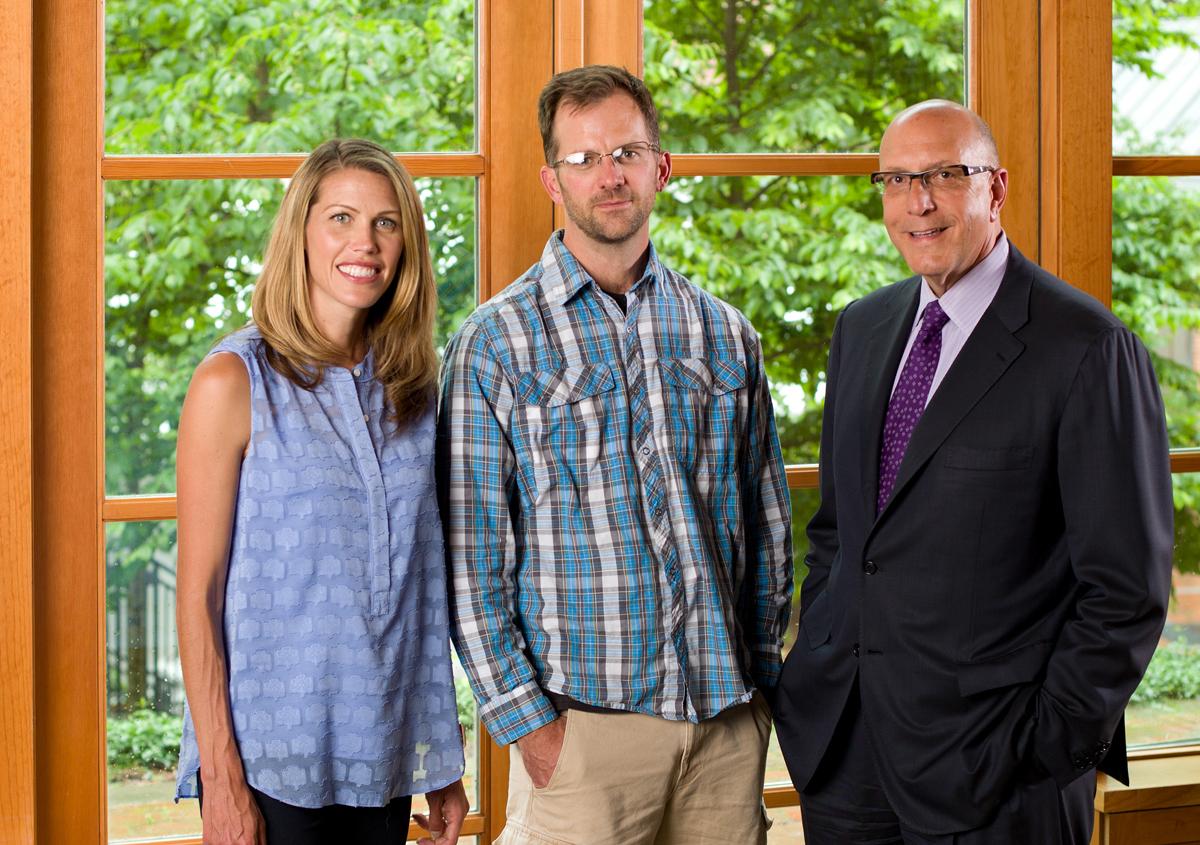
Sometimes it seems like business follows the law of the jungle—only without so many rules. That’s particularly true when it comes to corporate brand and reputation. If it isn’t your customers deciding they’ve had enough of you, it’s your competitors actively working to bring you down or a crisis you could have anticipated but didn’t staring you in the face. So Tuck Professor of Corporate Communication Paul Argenti was particularly interested in hearing about Dartmouth Associate Professor of Biological Sciences Ryan Calsbeek’s research on evolutionary biology.
Argenti’s son and Calsbeek’s daughter are friends from preschool and the two professors were chatting during a playdate at Argenti’s home. Calsbeek described how he and his wife Brittny, a lecturer in biology at Dartmouth and an expert in genomics, construct elaborate 3-D models of what is called the “adaptive landscape.” By creating hills and valleys representing different attributes of the environment, such as habitat and predators, and correlating it with traits of animals, such as body size and speed, they can predict how an animal will evolve over time and which combination of traits drive success in a given landscape.
It seemed to Argenti to be the perfect analogy for corporate reputation, his own field of study for 20 years, where companies work to balance the needs and perceptions of multiple constituencies including customers, shareholders, and employees and decide where to put their resources. “Is it possible to work with other forms of data?” asked Argenti. Despite extensive work by social scientists, a model that will take in all of the various factors and the way they interact with each other in determining reputation has remained elusive. “A lot of people consider that the Holy Grail in marketing and communications,” says Argenti. “No one has really cracked the code on how to do this in a way that would be meaningful in the boardroom.” Calsbeek was sure there was an application to this challenge. “He was tenacious and really wanted to do something with the idea,” Argenti remembers.
After more discussion, Argenti provided the Calsbeeks with data from the Reputation Institute, which measures companies along scales of corporate citizenship, employee satisfaction, governance, and other factors. The Calsbeeks were quickly able to grasp the ideas and work the data into their dynamic model. This afforded the advantage over other models of reputation by being able to predict how other companies may respond to changes a firm makes, rather than just showing a snapshot of the current state of communications. The model could also provide guidance to set strategic priorities, showing, for example, how the landscape might change if a company invested in a particular customer base, increased its focus on social responsibility, or reduced dollars to the ad budget.
“What this model does is allow you to think about the inter-relationship between variables,” says Argenti. “It’s kind of like playing chess in three dimensions.” When they presented the work to a group of executives at a conference last fall, they received ecstatic feedback about this potential new way to analyze and really leverage the vast and valuable data many companies work hard to collect but most fail to truly take advantage of. One Fortune 50 company approached them to analyze data related to the strength of their brand. Argenti and the Calsbeeks modeled internal and external data spanning financials, PR and social media, results of customer and prospect surveys, brand, reputation, employee satisfaction, and social responsibility to provide insight into how it would change based on the company’s future moves.
“Our model is able to tell them a much richer story,” says Argenti. “Having this outcome-based approach to measuring their reputation and their brand, we can use data to steer strategic decisions and investment, completely changing the way they think about this part of their business.” The company liked the analysis so much, they are considering expanding the collaboration to dive deep into the dynamics driving specific countries and to the way they manage their brand over time. Argenti and the Calsbeeks are now working on an article about their model, and are exploring commercializing it in the future given the response and interest generated to date. Argenti’s wife, Jennifer Kaye Argenti D’99, T’05 is a veteran of both startups and strategy consulting and has been interested in reputation since her time at Tuck. She has joined the team to lead this exploration and figure out how to offer the value created by the model to companies around the world.
Argenti credits the ingenuity and determination the Calsbeeks showed in developing a model that has the potential to transform the field of brand and reputation measurement. “How many scientists are willing to understand another field? And how many people in business have access to scientists like this?” he asks. “We are in a very lucky place where the stars have aligned in a way that gives us an incredible ability to predict the future.”
Building on Strength
A new cluster initiative concentrates Dartmouth’s strong suits.
Like a lens that focuses light from several different points at once, the effect of collaboration is multiplied exponentially when several faculty focus on an important global problem. That is the idea behind the Faculty Cluster Initiative, an ambitious program by the President and Provost’s Office at Dartmouth to hire new faculty to enhance the school’s areas of strength.
“It’s a way to attract new talent to Dartmouth, but to do it in areas where we already have real strength and exciting collaborations that we would like to encourage,” says Denise Anthony, vice provost for academic initiatives and former chair of the sociology department. “Adding one person here or there, even if they are rock stars, isn’t enough—but hiring three heavy-hitters in one area can really make an impact.”
The ideas for the initiatives come from faculty, who pitch subject areas where they would like to recruit colleagues to enhance an established area of strength or to build in an emerging field. After the proposals are vetted, the college goes out in search of donors to fund the initiatives and make them a reality. Making the initiative even more powerful is that donor contributions are met with a 50 percent match from the President’s Office to enhance the potential for the cluster. So far, four clusters have been funded, two of which will include new professors at Tuck—The Jack Byrne Academic Cluster in Decision Science and a cluster on The Challenges and Opportunities of Globalization.
The Byrne Cluster, established with a $20-million gift from longtime Tuck benefactor and former overseer Jack Byrne Jr. and his wife Dorothy, is currently undergoing a search for the Jack Byrne Distinguished Professor of Applied Mathematics, and will begin a search for a new professor at Tuck next year. “Decision sciences is a broad field that covers a number of faculty at Tuck and across Dartmouth who study economic decision-making,” says Anthony. “It is focused on interdisciplinary, high-impact research that has major global importance.” The Byrne Cluster is also unique in including funding for 32 Byrne Scholars, undergraduates who will receive grants to pursue independent studies in the field, and have rare access to Tuck faculty.
The Globalization cluster, funded with a $10-million gift from an anonymous alumnus, will build on Dartmouth’s reputation as a leader in international economics, focusing on research on how democratic principles can foster economic development and growth around the world. A third cluster, The William H. Neukom Academic Cluster in Computational Science, has already made its first hire, Rahul Sarpehskar, a bioengineer who began as a tenured professor at the Thayer School this fall.
Lastly, the Susan J. and Richard M. Levy ’60 Academic Cluster in Health Care Delivery Science won’t include a direct hire at Tuck, but it builds on the growing international reputation of Dartmouth as a center for innovation in the health care arena with programs like the Master of Health Care Delivery Science pioneered by Tuck and The Dartmouth Institute for Health Policy and Clinical Practice.
The possibilities for new clusters that have already been proposed for the future are a testament to the wide variety of areas in which Dartmouth is already a global leader—including a new cybersecurity cluster that would enhance the existing Institute for Security, Technology, and Society; and a new cluster on Ice, Climate, and Energy that would build on the work of faculty at Thayer, the Institute of Arctic Studies, and faculty from Environmental Studies. “The initiative is a little different than just building a department,” says Anthony. “This is a way to make a strategic investment in areas where Dartmouth has the potential for big impact if we add just the right mix of people.”
